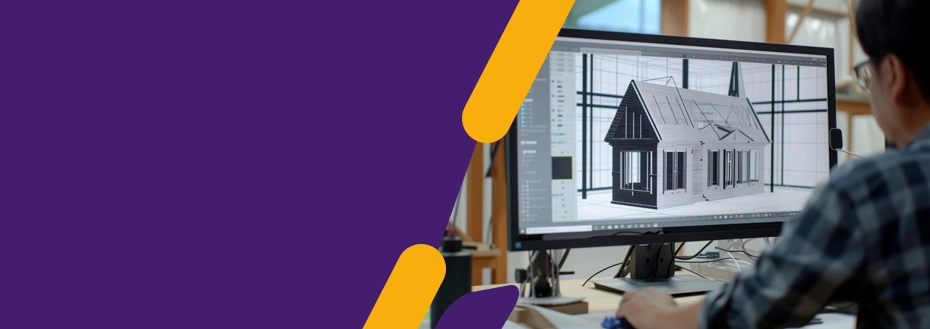As technology advanced, 3D modeling came into being in the 1960s. These digital representations found extensive use in the film and animation industry, owing to their enhanced realism and unique visual appeal. As technology progressed, so did the capabilities and applications of 3D modeling. By the 1980s, industries like architecture and engineering began to leverage these three-dimensional visual representations to conduct simulations and analysis.
The launch of AutoCAD by Autodesk in 1982 made it possible for engineers to create detailed and accurate models. This paradigm shift from manual 2D drafting to dynamic 3D models marked a significant milestone in transforming design processes across sectors. As of today, Autodesk products are considered industry standards by over 200 million users worldwide. This widespread adoption bears testimony to Autodesk’s pivotal role in the evolution of 3D modeling.
Powering Design with Autodesk Software for 3D Modeling
AutoCAD was only the beginning; in the realm of 3D modeling, Autodesk's tensive software portfolio includes 3D Studio (renamed to 3ds Max), Inventor, Maya, Revit, and Fusion. Each program has been meticulously designed with specific industries in mind. This level of precision and customization is exactly what makes Autodesk an innovator, a leader, and a game-changer.
Industry-wide Uses of Autodesk's Innovate Product Portfolio
The 3ds Max tool is a popular choice for architectural visualization, owing to its powerful rendering capabilities. Its robust polygon and texture modeling, coupled with impressive 3D animation, also makes it an option for game developers.
Engineers and industrial designers often vouch for Inventor. This widely recommended 3D CAD software comes with advanced documentation and product simulation tools. Also, Inventor's parametric modeling capability allows designers to make 3D models based on real-world performance and load and weight parameters.
On the other hand, Maya by Autodesk stands out as a premier 3D animation software. Used widely in the film, television, and gaming sectors, Maya supports stunning and detailed characters. Its sophisticated toolset allows for procedural and scripted animation, and its node-based 'Hypergraph' editor enables complex simulations and effects.
Architects and real-estate builders often turn to Autodesk Revit, a BIM software that helps create intelligent 3D models for buildings. Industry experts look up to Revit as a holistic tool that supports a building's entire life cycle, from conception to demolition.
Launched in 2013, Autodesk Fusion 360 introduced a cloud-based platform that integrates design, engineering, and manufacturing in a single, comprehensive package. It takes a unified approach to product development by merging 3D CAD, CAM, and CAE tools in a connected ecosystem. Designers use Fusion 360 to create complex models, engineers use it to analyze and simulate product performance, and manufacturers count on it to generate tool paths for machines.
How is Autodesk Catalyzing for Change in 3D Modeling Services?
Autodesk's influence on 3D modeling has been nothing short of transformative. They have been pushing boundaries and setting new standards in the industry since inception. Autodesk is not only known for its diverse and innovative portfolio but also for its approach to nurturing collaboration, creativity, and efficiency.
Did you know that Alias by Autodesk is extensively used as software for 3D modeling of car parts? Companies like General Motors also leverage and endorse Autodesk's contribution to 3D modeling by using their software extensively throughout their design process. The film and gaming industry too relies heavily on Autodesk. Popular Hollywood films and universally played games use Maya for 3D animation and visual effects. And when it comes to product design, Autodesk's Fusion 360 has been a bit of a game-changer. Companies like Adidas have leveraged this software to design and prototype new products. The aerospace and defense sectors are not too far behind; companies like Lockheed Martin, a leading global security and aerospace company, are known to use Autodesk Inventor for designing and testing complex mechanical systems.
How Can You Leverage Autodesk for Your Business?
If you are in the architectural, engineering, or construction business, you can leverage Autodesk's extensive portfolio of tools and software to save costs, perfect product designs, and take the outcomes to the next level.
Streamline Product Design & Manufacturing
Using AutoCAD, your product engineers can visualize and simulate products before they are built. Consider replacing existing tools and processes to make way for improved product quality and reduced time to market.
Create Detailed Designs
You can leverage software for 3D design like Revit and Civil 3D to create and simulate detailed architectural designs. You can test the viability of your designs, look for discrepancies in design, and manage construction projects way more effectively.
Education & Training
Save your projects from the throes of technological obscurity. Train your in-house engineers and designers using the educational versions of Autodesk software.
Collaboration & Project Management
BIM 360 by Autodesk offers a unified platform to all stakeholders in a construction project. Using document management, design collaboration, and model coordination features, all the teams can track progress or make changes in real time.
Sustainability & Energy Management
Autodesk has tools that can help model and analyze energy consumption, life cycle costs, and daylighting scenarios to help your business become more sustainable.
The Conclusion
3D modeling is the present and the future of engineering and architectural design. Its realistic visualizations, precise measurements, and efficient design modification make it ideal for presentations, design changes, and experimentation. The rapid iterations make it cost-effective and hassle-free as well. Autodesk will hold fair stakes in this future; it is already recognized as an industry leader in engineering software. Make sure you ride the tide of technological advancement with Autodesk to give your projects a competitive edge.
Contact UsAvail best-in-class services at affordable rates
Our Customers





Key Differentiators
Case Studies
-
Flatworld Solutions provided customized CNC programming using MasterCAM
-
Flatworld Provided CFD Simulation Services to a Leading HVAC Products Manufacturer
-
Flatworld Solutions Offered Mechanical Instrument Drafting and Detailing Services to an Engineering Consultant
-
Flatworld Solutions Offered US Client with 2D to 3D Mechanical Legacy Drawing Conversion
-
Flatworld Solutions Provided Reverse Engineering of Machine Parts to a Client
Join the growth phase at Flatworld Solutions as a Partner
Service distributorship and Marketing partner roles are available in select countries. If you have a local sales team or are a person of influence in key areas of outsourcing, it's time to engage fruitfully to ensure long term financial benefits. Currently business partnerships are open for Photo Editing, Graphic Design, Desktop Publishing, 2D and 3D Animation, Video Editing, CAD Engineering Design and Virtual Walkthroughs.
Reach out to us for a quick direct response from decision makers at the Flatworld Solutions global team.

USA
Flatworld Solutions
116 Village Blvd, Suite 200, Princeton, NJ 08540
PHILIPPINES
Aeon Towers, J.P. Laurel Avenue, Bajada, Davao 8000
KSS Building, Buhangin Road Cor Olive Street, Davao City 8000



